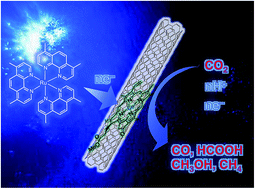当前位置:
X-MOL 学术
›
Chem. Sci.
›
论文详情
Our official English website, www.x-mol.net, welcomes your feedback! (Note: you will need to create a separate account there.)
Mechanisms of catalytic reduction of CO2 with heme and nonheme metal complexes
Chemical Science ( IF 8.4 ) Pub Date : 2018-07-02 00:00:00 , DOI: 10.1039/c8sc02220h Shunichi Fukuzumi 1, 2, 3, 4, 5 , Yong-Min Lee 1, 2, 3, 4, 6 , Hyun S. Ahn 4, 7, 8, 9 , Wonwoo Nam 1, 2, 3, 4, 10
Chemical Science ( IF 8.4 ) Pub Date : 2018-07-02 00:00:00 , DOI: 10.1039/c8sc02220h Shunichi Fukuzumi 1, 2, 3, 4, 5 , Yong-Min Lee 1, 2, 3, 4, 6 , Hyun S. Ahn 4, 7, 8, 9 , Wonwoo Nam 1, 2, 3, 4, 10
Affiliation

|
The catalytic conversion of CO2 into valuable chemicals and fuels has attracted increasing attention, providing a promising route for mitigating the greenhouse effect of CO2 and also meeting the global energy demand. Among many homogeneous and heterogeneous catalysts for CO2 reduction, this mini-review is focused on heme and nonheme metal complexes that act as effective catalysts for the electrocatalytic and photocatalytic reduction of CO2. Because metalloporphyrinoids show strong absorption in the visible region, which is sensitive to the oxidation states of the metals and ligands, they are suited for the detection of reactive intermediates in the catalytic CO2 reduction cycle by electronic absorption spectroscopy. The first part of this review deals with the catalytic mechanism for the one-electron reduction of CO2 to oxalic acid with heme and nonheme metal complexes, with an emphasis on how the formation of highly energetic CO2˙ is avoided. Then, the catalytic mechanism of two-electron reduction of CO2 to produce CO and H2O is compared with that to produce HCOOH. The effect of metals and ligands of the heme and nonheme complexes on the CO or HCOOH product selectivity is also discussed. The catalytic mechanisms of multi-electron reduction of CO2 to methanol (six-electron reduced product) and methane (eight-electron reduced product) are also discussed for both electrocatalytic and photocatalytic systems.
中文翻译:

血红素和非血红素金属配合物 催化还原CO 2的机理
将CO 2催化转化为有价值的化学品和燃料已引起越来越多的关注,这为缓解CO 2的温室效应并满足全球能源需求提供了有希望的途径。在许多用于CO 2还原的均相和非均相催化剂中,本篇综述集中于血红素和非血红素金属络合物,这些络合物可作为有效催化电还原CO 2和光催化还原CO 2的催化剂。由于金属卟啉类化合物在可见光区域显示出强吸收性,因此对金属和配体的氧化态敏感,因此它们适用于检测催化性CO 2中的反应性中间体通过电子吸收光谱进行还原循环。的与催化机制CO的单电子还原此评论的第一部分是2至草酸与血红素和非血红素金属配合物,并就如何高能CO的形成强调2 ˙得以避免。然后,将CO 2的双电子还原产生CO和H 2 O的催化机理与产生HCOOH的催化机理进行了比较。还讨论了血红素和非血红素配合物的金属和配体对CO或HCOOH产物选择性的影响。CO 2多电子还原的催化机理 对于电催化和光催化体系,还讨论了甲醇制得的甲醇(六电子还原产物)和甲烷(八电子还原产物)。
更新日期:2018-07-02
中文翻译:

血红素和非血红素金属配合物 催化还原CO 2的机理
将CO 2催化转化为有价值的化学品和燃料已引起越来越多的关注,这为缓解CO 2的温室效应并满足全球能源需求提供了有希望的途径。在许多用于CO 2还原的均相和非均相催化剂中,本篇综述集中于血红素和非血红素金属络合物,这些络合物可作为有效催化电还原CO 2和光催化还原CO 2的催化剂。由于金属卟啉类化合物在可见光区域显示出强吸收性,因此对金属和配体的氧化态敏感,因此它们适用于检测催化性CO 2中的反应性中间体通过电子吸收光谱进行还原循环。的与催化机制CO的单电子还原此评论的第一部分是2至草酸与血红素和非血红素金属配合物,并就如何高能CO的形成强调2 ˙得以避免。然后,将CO 2的双电子还原产生CO和H 2 O的催化机理与产生HCOOH的催化机理进行了比较。还讨论了血红素和非血红素配合物的金属和配体对CO或HCOOH产物选择性的影响。CO 2多电子还原的催化机理 对于电催化和光催化体系,还讨论了甲醇制得的甲醇(六电子还原产物)和甲烷(八电子还原产物)。



























 京公网安备 11010802027423号
京公网安备 11010802027423号